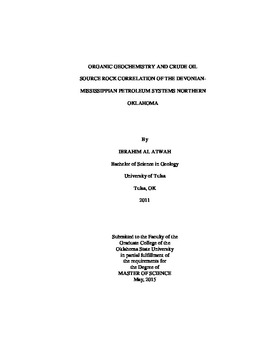| dc.description.abstract | The Mississippian limestone in northern Oklahoma and southern Kansas is a major oil play within the southern Midcontinent region. Mississippian carbonate reservoirs are known for their heterogeneity with respect to reservoir quality and produced fluids. Oil and gas from the Mississippian reservoirs are chemically heterogeneous, and cannot be explained solely by a single Woodford Shale source-rock model. New molecular geochemical data from east and west of the Nemaha uplift in north-central Oklahoma provides a new insight into the source of hydrocarbons in the Mississippian play, and attempts to provide a plausible scenario of the hydrocarbon charge history. Organic-rich zones within the Mississippian carbonate section were sampled and screened for total organic carbon (TOC), organic petrography, Rock-Eval pyrolysis and geochemical markers. Additionally, twelve oil samples were analyzed from Mississippian and Woodford producing wells. Rock extracts and oil samples were analyzed using gas-chromatography and gas-chromatography mass-spectrometry techniques for quantitative analysis of diamondoids, saturate and aromatic biomarkers. Results indicate that the Mississippian source-rock has good generation potential (average 2% TOC) and reached the early oil window (average vitrinite reflectance of 0.74% Ro). Extracted bitumen from Mississippian rocks and related oils show unique biomarker signatures; these include the presence of extended tricyclic terpane, high gammacerane index, and high C23 tricyclic terpane relative to hopane, high input of C27 relative to C28 and C29 in regular and rearranged steranes, together with high C27 monoaromatic steroids relative to their C28 and C29 homologues. Moreover, on the basis of diamondoid compound class, the Mississippian samples showed abundance of 4,8- and 4,9-dimethyl dimantanes relative to the 3,4- isomer. The extent of cracking as measured by diamondoids reveals a dramatic change in diamondoid concentration across the Nemaha uplift. A high concentration of diamondoids was observed west of the Nemaha uplift, thus indicating episodic hydrocarbon charge of uncracked oil followed by cracked oil migrating out of the Anadarko Basin, which supports a long-distance migration model. In contrast, the Mississippian samples from east of the Nemaha uplift are depleted in diamondoids, suggesting limited migration and localized hydrocarbon generation under lower thermal stress. | |
